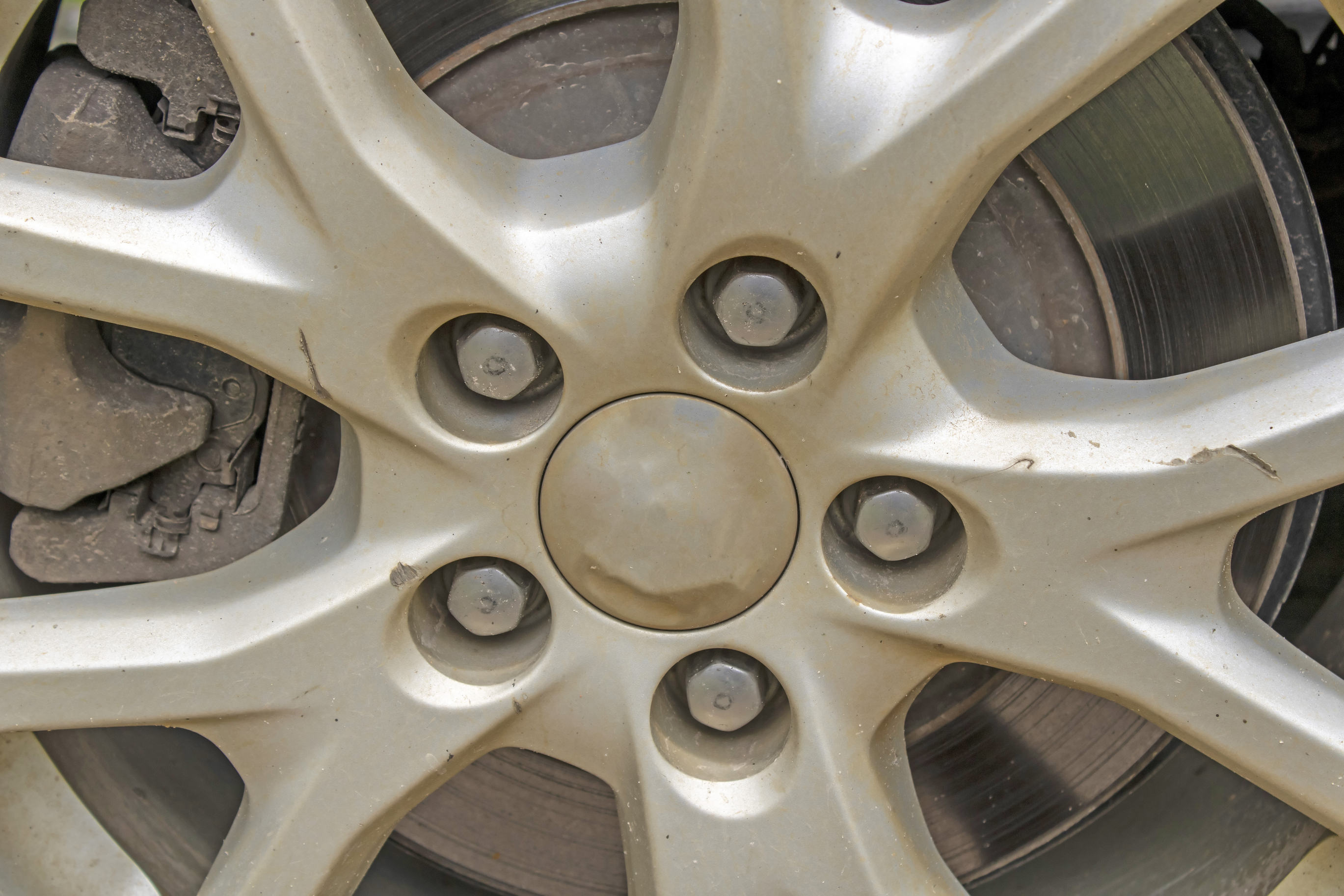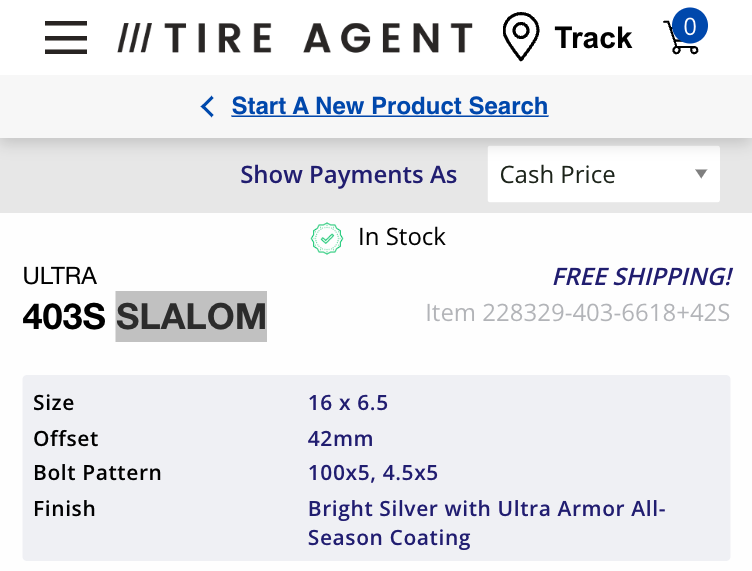Your Shopping Cart
Your cart is empty.
Subtotal ( items)
Instant Rebate Applied:
Promo Code Applied: ID.me Discount Applied:
Have a Promo Code?
Size:
Item
Item
Selected for:
/ each
Add-Ons
Wireless air pump capable of pumping up to 150 psi with 2000 MAH power bank.



Fully protect your clothes and vehicle interior during transportation of your tires. For Tires up to 31" tall and wheels up to 22".
Per sensor
Add TPMS Sensors
/per sensor
Please confirm the make, year, model and trim of the vehicle you want to purchase for:
How many sensors do you need?
The vehicle you have selected is not compatible with aftermarket TPMS Sensors.
Enter a different vehicle to add TPMS sensors

 Front Tire Size:
Front Tire Size:
 Rear Tire Size:
Rear Tire Size:
 Your Vehicle:
Your Vehicle:
Pros & Cons of Staggered Fitment

Attractive Design

Improved Handling

Improved Cornering
Bumpier Ride
Poor Traction in Snow
How do I find my tire size?



Need help?
 Your Vehicle:
Your Vehicle:
Pros & Cons of Staggered Fitment

Attractive Design

Improved Handling

Improved Cornering
Bumpier Ride
Poor Traction in Snow
How do I find my tire size?



Need help?
Pros & Cons of Staggered Fitment

Attractive Design

Improved Handling

Improved Cornering
Bumpier Ride
Poor Traction in Snow
Need help?
Need help?
How do I know if I have an LT tire?

 Your Vehicle:
Your Vehicle:
Sorry, we could not find any available
wheels for your sizing selections.
Need help?
What is My Bolt Pattern? How To Find Your Vehicle’s Lug Pattern
By Tire Agent Staff
May 29, 2022
Is it time to replace the wheels or tires on your ride? There are a couple of reasons you might want to. Let's begin by making sure you know what we're talking about when mentioning wheels and tires, as they are not the same.
A wheel is the metal component that connects to the hub of your car through an axle. The tire is a rubber casing attached to the wheel. Tap or click here for our report describing the difference between rims and wheels.
You might want to replace your old wheels because they could be damaged after years of use. You want to avoid driving with damaged wheels, which can significantly impact how your vehicle handles. Safety always comes first.
Another reason to get new wheels is if you want a fresh look for your vehicle. There are so many sharp-looking wheels to choose from that can make your car stand out in a crowd.
As you decide on your next set of wheels, you might hear experts talk about bolt patterns or lug patterns. Keep reading to find out what bolt pattern is, how to know what bolt pattern your vehicle has and why it matters.
How Many Lug Nuts Are on a Standard Car Wheel?
A standard car wheel typically has 5 lug nuts. However, some vehicles may have 3 to 5 lug nuts per wheel, depending on the make and model. It's essential to check your specific vehicle's manual to confirm the exact number of lug nuts. For most cars, having four lug nuts per wheel is common and safe.
What Is a Bolt Pattern?
The bolt pattern of a tire indicates how many bolts or lug nuts are used to secure a wheel to your vehicle and the diameter of the pitch circle. I know. That sounds confusing.
Let's break it down. There are two numbers to look for in a bolt pattern. For example, 5×110. The first number means five bolt or lug holes on the wheel.
Then what does the 110 number mean? The boltholes at the center of your wheel form an imaginary circle. The diameter of the imaginary circle around those holes determines the second number.
So our wheel with a bolt pattern of 5×110 means five boltholes are evenly spaced around a circle with a 110 mm diameter.
Why Does Bolt Pattern Matter?
Safety. Safety. Safety.
Knowing your bolt pattern is crucial because it determines how your lug nuts lock your wheels to your vehicle. The correct bolt pattern ensures a secure fit.
What Is the Most Common Lug Pattern?
Wheels come in several bolt patterns. You'll find wheels with three, four, five, six or eight boltholes. The most common are four and five bolt patterns.
The size of a vehicle typically determines its wheels' lug pattern. Smaller vehicles will require fewer lug holes and larger vehicles more. Passenger cars usually have four lug holes.
SUVs, pickup trucks and larger vehicles will generally have wheels with five or more lug holes.
What Bolt Pattern Is My Car?
Your first step is to look at the wheels on your vehicle. You can determine the first number in its bolt pattern visually. If you see five lug nuts, its bolt pattern begins with the number five.
Honestly, the easiest way to determine your vehicle's bolt pattern is to go to Tire Agent's website and enter the make and model of your car. Once you enter that information, Tire Agent will only show you compatible tires and wheels.
Here's an example of what you'll see when searching Tire Agent for wheels:
Notice the Bolt Pattern section that shows this vehicle is 100x5.
That was a deep dive into bolt patterns. But there are other factors that help determine the correct wheel for your vehicle. Here are a couple more factors.
Wheel Offset
The distance between the wheel's mounting surface and the centerline, measured in millimeters, is known as wheel offset.
Check out our report on wheel offset and how to choose offset for new rims for more details. It's a great resource to help you better understand wheel offset.
Center Bore
The machined opening in the middle of a wheel that centers the wheel properly on a vehicle is known as the center bore. A wheel must be "Hub Centric" to reduce vibration.
Lug Nut Sizes
The lug nut size must match your vehicle's requirements to install your wheels safely. If your lug nuts or bolts don’t fit your vehicle’s thread pitch, they won’t work.
Two numbers represent lug nut sizes. The first number is the stud's diameter. The thread pitch is the second number. The thread pitch on metric studs is the spacing in millimeters between each thread. The thread pitch on standard lug nuts is the number of threads per inch.
An example of a standard lug nut size is 12mm X 1.75. That indicates a 12mm diameter and a 1.75 thread pitch.
How to Qualify for the $50 Offer
- Add items to your cart and begin checkout.
- Select PayPair and apply for financing.
- If you’re approved by a participating lender, you’ll see a $50 promotional rebate applied to your order total.
-
To receive the $50, you must:
- Complete your purchase with a qualifying lender,
- Agree to the payment terms,
- And make the required number of consecutive on-time payments, as specified by the lender.
Note: Offer available only through select lenders. Additional eligibility requirements and conditions apply. Rebate may be issued after verification of qualifying payment activity. Terms subject to change.
How to Purchase Tires and Wheels
With a Payment Plan
Tire Agent's payment plans make it easy to get the best partial or full set of tires and wheels for your vehicle.
It's fast, secure and won't affect your credit score
Match with multiple lenders
Why Choose PayPair?
PayPair’s Partners and Plans

No Money Down

No Money Down

No Credit Needed*

No Money Down

$1 to Start!*

No Money Down

No Credit Needed*

$1 to Start!*

No Money Down
Other Payment Plans

$0 to Little Down

Pay with your bank account

Simplified checkout experience

Faster and easier than using cards or cash

Simplified checkout experience

Faster and easier than using cards or cash
*SNAP: The advertised service is a lease-to-own agreement provided by Snap RTO LLC. Lease-to-own financing is not available to residents of Minnesota, New Jersey and Wisconsin. NO CREDIT NEEDED: Not all applicants are approved. While no credit history is required, Snap obtains information from consumer reporting agencies in connection with applications, and your score with those agencies may be affected. PAYMENT PLAN: The standard plan consists of renewable lease terms. To exercise an early ownership, consumers must make regular payments on time and schedule additional payments via the customer portal or by contacting Customer Care at 1-877-557-3769. KATAPULT: The Promotional Initial Payment (plus any applicable taxes and fees) is due at lease signing. Your lease-purchase payment amount will be determined after you select your product(s). You will not acquire ownership of the product(s) if the total amount necessary to acquire ownership is not paid. The Promotional Initial Payment does not reduce the cost of the lease-purchase agreement. The Promotional Initial Payment is only available when shopping at Tire Agent through the Katapult mobile app and at Tire Agent’s website. Product pricing subject to change and availability. Disclosure: 90-day early purchase option (EPO) terms and conditions apply: 90-Day (3 months in CA) You can buy out your lease-to-own agreement within the first 90-days. This amount includes the cash price, plus the lease-to-own cost for the first 90-days. Taking advantage of the 90-day purchase option will save you the most money! PROGRESSIVE: Ownership by rental/lease agreement with Progressive Leasing costs more than the retailer’s cash price. Select items only. Cancel or purchase early at any time. Not available in MN, NJ, VT, WI, WY. Progressive Leasing obtains information from credit bureaus. Not all applicants are approved. Standard agreement offers 12 months to ownership. 90-day purchase options cost more than the retailer’s cash price (except 3-month option in CA). To purchase early or to cancel lease, you must call 877-898-1970. Retailer cannot activate early purchase options.


